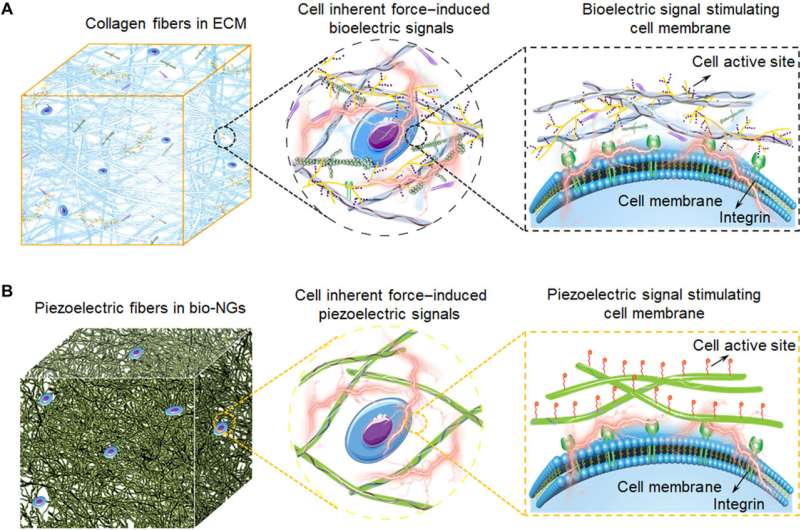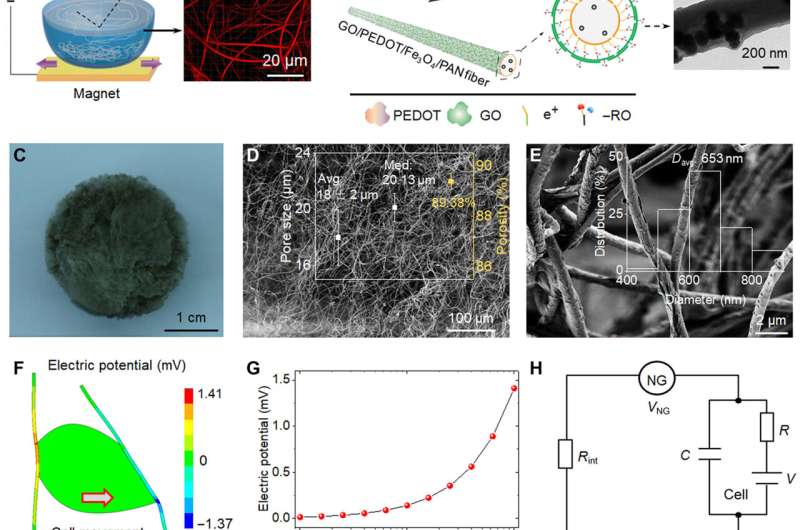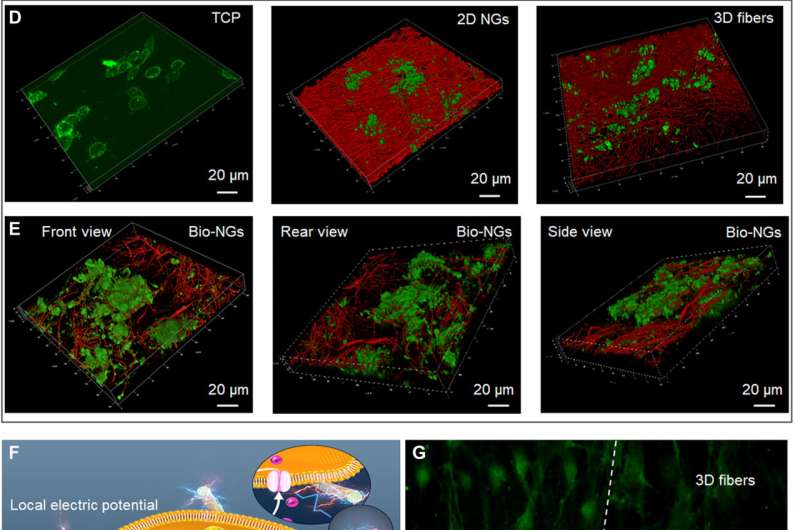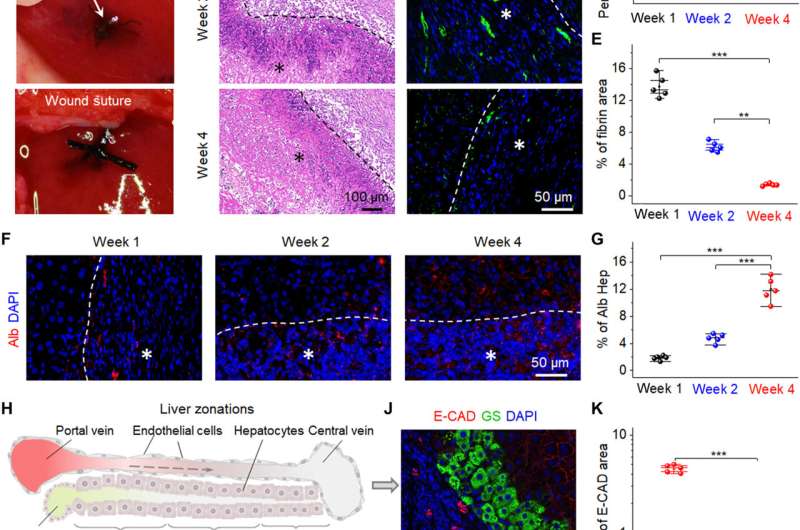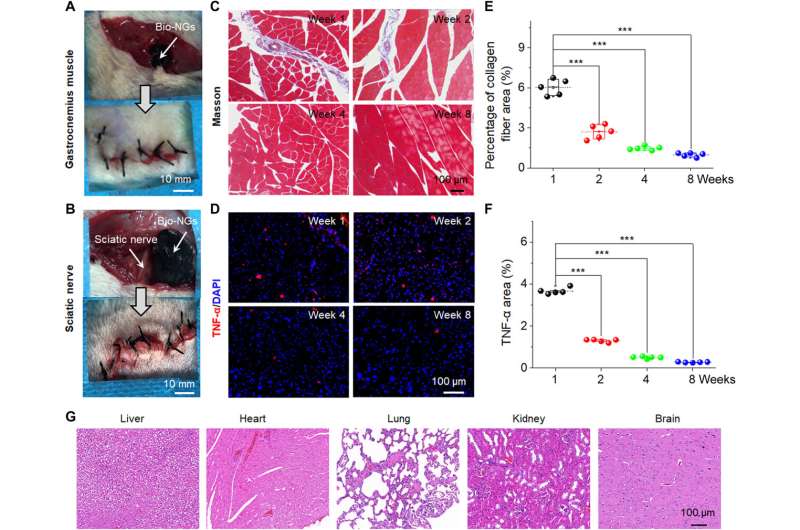Schematic illustrations of electromechanical coupling bio-NGs modulating cell activity inspired by ECM. (A) The collagen fibers in ECM converting the cell inherent force into bioelectricity, which also constitutes the 3D architecture of ECM. These bioelectric signals are transmitted by signal molecules filled between collagen fibers, thus, to regulate cell activity and realize the functional expression of cells. (B) Schematic diagram of the bioinspired piezoelectric fibers in bio-NGs. The interaction of cells with bio-NGs emulating this bioelectric signal in ECM induces, in response to the inherent forces produced by the cells, a local electric field that stimulates and modulates their cell activity. Credit: Science Advances, 10.1126/sciadv.abh2350
The unique 3D space within the bio-NGs provided an ECM-like environment to promote cell growth. The bio-NGs effectively promoted cell viability and development to maintain its specific functional expression. Researchers expect the new and advanced bio-NGs to mimic the complexity of the extracellular matrix and provide a physiologically relevant in vivo biological system. The device effectively promoted cell viability and development to maintain its specific functional expression. Li et al. expect the new and advanced version of bio-nanogenerators to provide a physiologically relevant in vivo biological system to replace inaccurate 2D systems and animal models.
Guidance for cells
In this work, Li et al. outlined a practical strategy for wireless electrical stimulation of cells and tissues to repair and sustain cell function. Bioelectricity is a biophysical cue that provides guidance for cell growth and differentiation during embryonic development and tissue regeneration. Endogenous bioelectricity exists in the cytoplasm and extracellular space, providing scientists a resource for electrical stimulation of excitable cells and regulating cellular activity for biomedical applications. Most treatment methods require an external energy input and wire connection to apply external electrical pulses through implanted microdevices. Recent developments in nanotechnology have allowed electrode-less and battery-free treatments, which include the use of nanogenerators for brain stimulation, hair regeneration and wound healing. However, most of them require a well-accepted solution to electrically stimulate the functional cells. Li et al. were therefore inspired by the biological function and microstructure of collagen fibers in the extracellular matrix to form bio-NGs composed of highly discrete piezoelectric electrospun fibers to provide cells with a physically relevant microenvironment. The bio-NG-cell interaction applies to in vivo environments to reduce inflammation, induce hepatocyte proliferation, and accelerate angiogenesis, as well as promote liver repair.
Schematic representation and piezoelectric analysis of bio-NGs. (A) Schematic diagram of the fabrication of highly discrete piezoelectric Fe3O4/PAN fibers. With the help of the neodymium iron boron magnet, Fe3O4 magnetic nanoparticles were introduced into PAN electrospun solution to break through the surface tension of water. (B) The PEDOT conductive layer was loaded with the method of in situ polymerization; GO nanosheets were adsorbed on the outermost layer of fibers by the contribution of electrostatic adsorption force to form the target GO/PEDOT/Fe3O4/PAN fibers. Transmission electron microscopy images of the single fiber obtained in every step. (C to E) Optical image and scanning electron microscopy (SEM) images of the bio-NGs. The inset of (D) shows pore size distribution and porosity. The inset of (E) shows the fiber diameter distribution range of the GO/PEDOT/Fe3O4/PAN fibers. (F) Finite element analysis simulation of piezoelectric fibers coupled with a living cell generating a maximum voltage of 141 mV when strained by a tangential force of 10 nN. (G) Piezoelectric potential generated by a single fiber as a function of the applied tangential cell force. (H) Simplified resistor-capacitor circuit created by the NG, the NG-cell interface, and the cell membrane. (I) Piezoelectric force microscopy (PFM) phase and PFM amplitude images of a single fiber in bio-NGs. (J) Phase-electric potential hysteresis and butterfly amplitude loops of fibers in bio-NGs, obtained with a DC voltage varying from −10 to 10 V. (K) Voltage outputs from the bio-NGs under the same impact force of 1 N (blue) and under a vibration at 0.7 Hz (red). The inset represented the impact (left) and vibration (right) methods used to characterize the fibers in bio-NGs. F, force. Photo credit: Chuanmei Shi, Nanjing University of Science and Technology. Credit: Science Advances, 10.1126/sciadv.abh2350
Forming the bioinspired electromechanical bio-NGs.
During the experiments, the research team introduced iron oxide magnetic nanoparticles into polyacrylonitrile to prepare highly discrete fibers for use as a magnetic-assisted electrospinning device. During electrospinning, the setup enabled the formation of scaffolds with well-interconnected pores and discrete fibers for cell-free migration. To prepare a closer-to-in-vivo microenvironment, the team also imparted bioelectricity as a biophysical cue. To accomplish this, the scientists developed a target scaffold to promote cell interaction and adhesion with fibers. The electromechanical coupling of bio-NGs assembled by the scaffold promoted the transmission and communication of signals between cells to mimic the bioelectric effects of collagen fibrils or fibers in the extracellular matrix. The team simulated and studied the piezoelectric potential generated from cell force in bio-NGs using finite element analysis. To accomplish this, they applied a load force to the cell-fiber contact and first measured the piezoelectricity of a single fiber within bio-NGs using piezoelectric force microscopy. The experimental voltage signals validated the theoretical piezoelectricity of the bio-NGs.
Characterizing the bio-NGs and regulating cell activity
The growth and development of RGC5 neurons in bio-NGs. (A) Proliferation of RGC5 neurons by the DNA assay on days 1, 3, and 5. (B) Apoptosis of RGC5 neurons after 5 days of culture in bio-NGs. (C) Neurite outgrowth of RGC5 neurons by the median neurite length after 5 days of culture in bio-NGs. (D) 3D confocal scanning of RGC5 neurons cultured on TCP, 2D NGs, and 3D fibers. (E) 3D confocal scanning of RGC5 neurons cultured in bio-NGs from different perspectives. (F) Inherent cell force of living cells grown in bio-NGs. This would induce a local electrical field proportional to the strain level that could eventually alter the membrane potential and/or the configuration of membrane receptors and results in the opening of the Ca2+ channels. Ins3P, inositol trisphosphate. PLC, phospholipase C. (G) The fluorescence images of the cells preincubated with Fluo-4 AM (membrane-permeable and Ca2+-dependent dye) on the fibers in bio-NGs and 3D fibers. Green, Ca2+. All error bars indicate ±SD. Credit: Science Advances, 10.1126/sciadv.abh2350
To investigate the information of the fibers in bio-NGs, the team used Fourier Transform Infrared (FTIR) and X-ray diffraction (XRD) spectra. They then studied the thermodynamic properties of the piezoelectric fibers in bio-NGs using differential scanning calorimetry (DSC) thermograms and conducted cyclic voltammogram studies to test the charge storage and transmission properties of the piezoelectric fibers in bio-NGs. The team then tested the compressive resilience and mechanical properties of the fibers by first forming cylindrical shapes of them and compressing the scaffolds to understand the excellent resilience of the constructs. The mechanical properties and resilience of the fibers ensured the bio-NGs could effectively maintain a large enough pore size and stable 3D growth microenvironment for cell movement and growth. The team also investigated the NG-cell interaction in 3D space with two different cell lines including
retinal ganglion cell 5 (RGC5) and primary hepatocytes. The cells contained voltage-gated calcium channels in their membranes and others were motile cells with high metabolic functions. Using two-dimensional nanogenerators (NGs) and non-piezoelectric 3D fibers the team studied the effects of 3D space and electrical stimulation on cells. The data showed how the bio-NGs could provide a biofriendly cell culture microenvironment for further experiments.
Promoting in vivo liver repair with bio-NGs
Liver repair promotion by bio-NGs in vivo. (A) Surgical images showing the implantation of the bio-NGs into the liver defect. (B) H&E staining of the liver sections at different time points (weeks 1, 2, and 4) after implantation. (C) Representative images of hepatic fibrin(ogen) immunostaining (green) in 4′,6-diamidino-2-phenylindole (DAPI) (blue)–counterstained liver sections at the implanted area. (D) Average percentage of the positive area measured from H&E staining. (E) Quantification of hepatic fibrin immunofluorescent labeling. (F) Immunostaining for Alb (red) on liver sections at different time points (weeks 1, 2, and 4) after implantation. (G) Alb expression level measured from Alb immunostaining. (H) Schematic showing three liver zones from the periportal to the pericentral region. 1, 2, and 3 indicate zone 1 (E-CAD+), zone 2 (E-CAD─GS─), and zone 3 (GS+), respectively. The dashed arrow indicates blood flow. (I and J) Immunostaining for GS (green) and E-CAD (red) on liver sections at the fourth week after implantation. (K) Quantification of GS and E-CAD showing stronger expression of liver function of new hepatocytes in bio-NGs than that of 3D fibers. Hep, hepatocyte. Asterisks (*) show locations of the implantation. Data are expressed as mean values ± SD. n = 5. **P < 0.01 and ***P < 0.001. Photo credit: Fei Jin, Nanjing University of Science and Technology. Credit: Science Advances, 10.1126/sciadv.abh2350
The scientists then implanted the bio-NGs into an area of liver injury relative to hepatocyte regeneration to reflect their practicality. To accomplish this, they used Sprague-Dawley rats to induce liver injury. After four weeks of implanting the bio-NGs, the team removed the implants and studied inflammation using histology staining. They noted mild inflammation in the first week, which improved by the second week and reduced to normal levels by the fourth week. All other organs did not show deformation or abnormal lymphatic cell invasion to indicate good health conditions without systematic side effects. The observed regenerative process highlighted a new blood circulation system that formed inside regenerated liver tissue to suggest the interaction of bio-NGs with cells to reduce inflammation and promote tissue repair.
Long term stability and biocompatibility of bio-NGs in vivo
The NG-cell interaction efficiently promoted cell viability and maintained its functional expression in vitro and in vivo to provide a treatment strategy for clinical trials. For tissue regeneration, it is most effective to directly transplant functional cells into the damaged site in vivo. For additional studies, the team implanted the bio-NGs into the gastrocnemius muscle area around the sciatic nerve of rats to detect the stability of the bio-NGs in vivo. Li et al. then removed the implants after eight weeks and analyzed inflammation to show good biocompatibility of bio-NGs for prolonged periods of time in biological environments without any systemic side effects. The constructs are promising as implants for in vivo regenerative repair.
In vivo stability and biocompatibility of bio-NGs. Surgical image showing the implantation of the bio-NGs into the (A) gastrocnemius muscle and (B) sciatic nerve areas of a mouse. (C) Masson trichrome staining of gastrocnemius muscles at the implanted area. (D) TNF-α immunofluorescent staining of sciatic nerve at the implanted area. (E) Average percentage of collagen fibers in the muscle tissue measured from Masson staining. (F) Relative TNF-α expression level measured from TNF-α immunofluorescent staining. (G) H&E staining of vital organs (liver, heart, lung, kidney, and brain) at week 8 after implantation in the sciatic nerve area. Data are expressed as mean values ± SD. n = 5. ***P < 0.001. Photo credit: Tong Li, Nanjing University of Science and Technology. Credit: Science Advances, 10.1126/sciadv.abh2350
Outlook
In this way, Tong Li and colleagues developed extracellular matrix-like electromechanical coupling bio-nanogenerators (bio-NGs) to regulate cell activity and maintain its specific functional expression. The product created a local voltage potential to stimulate living cells as long as they remained motile. The unique environment facilitated cell culture in bio-NGs to trigger the opening of ion channels present in the cellular plasma membrane to achieve electrical stimulation at the single-cell level. The process offers great potential for bioelectronic medicine and cell-targeted local electrical impulses. The new method can replace inaccurate 2D systems and time-consuming animal models to provide a biomimetic, physiological microenvironment for accelerated tissue regeneration and bioinspired electronic medicine.
More information: Tong Li et al, Cell activity modulation and its specific function maintenance by bioinspired electromechanical nanogenerator, Science Advances (2021). DOI: 10.1126/sciadv.abh2350
Qiang Zheng et al, Self-powered cardiovascular electronic devices and systems, Nature Reviews Cardiology (2020). DOI: 10.1038/s41569-020-0426-4
Journal information: Science Advances
© 2021 Science X Network
